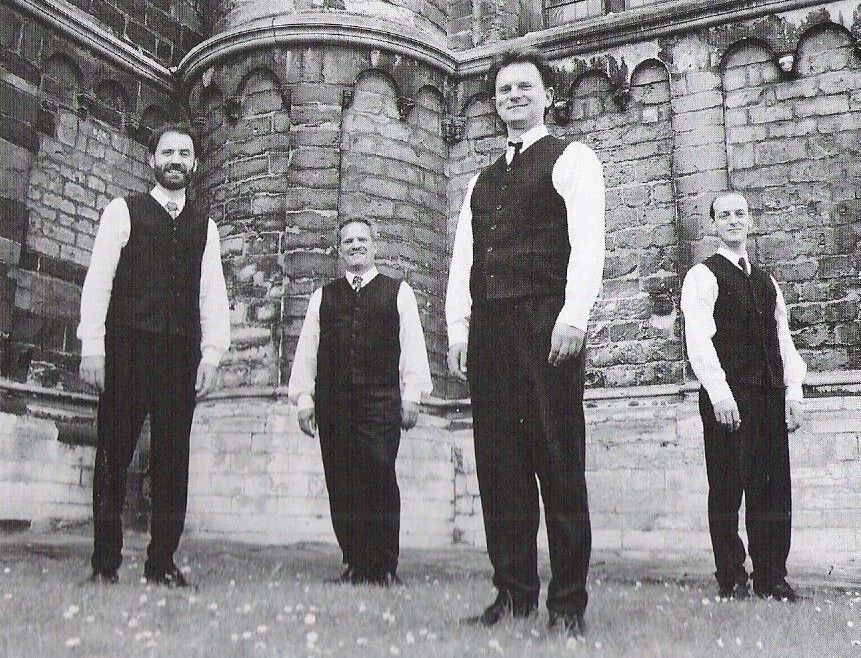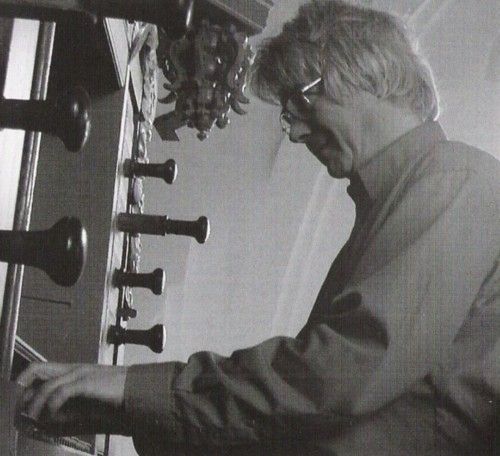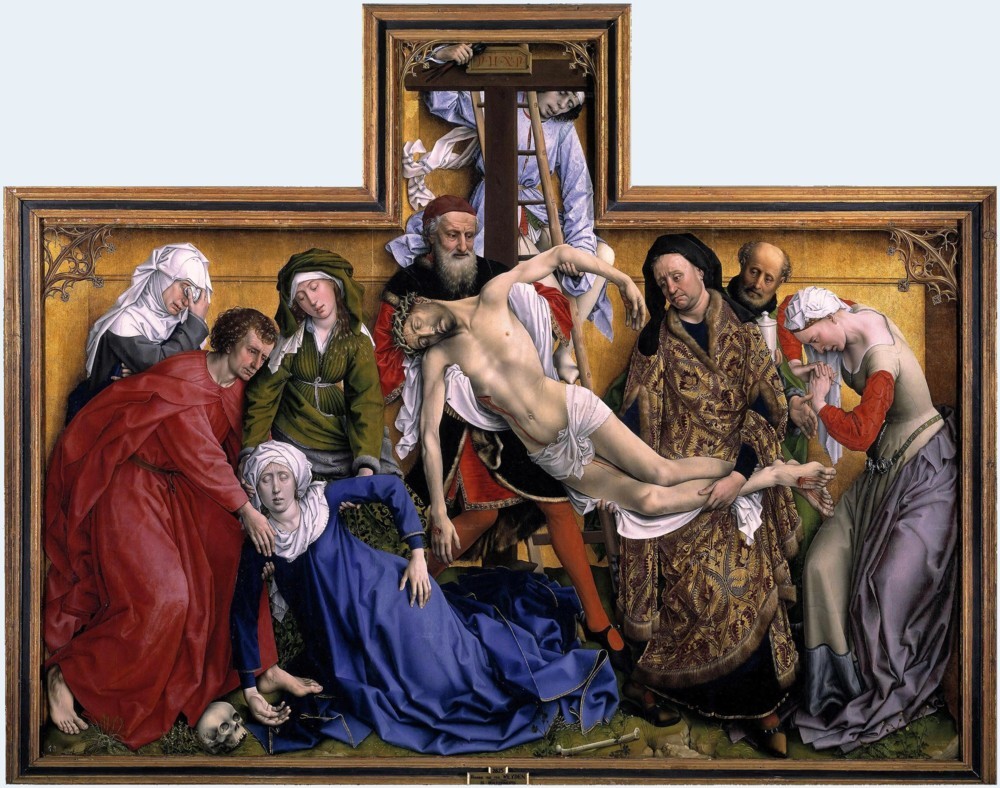Johannes PRIORIS. Missa pro defunctis
Capilla Flamenca | Joris Verdin

medieval.org
capilla.be
Eufoda 1349
2003
VITA
Johannes PRIORIS (ca. 1460-1512|1514)
1. Alleluja. O filii, o filiae [4:10]
Hans KOTTER (ca. 1480-1541)
2. Prooemium in Re [1:38]
organ
Johannes PRIORIS
3. Royne du ciel | Regina caeli [5:30]
4. Ave Maria [1:07]
anoniem
5. Ricerchare di Jaches [1:54]
Johannes PRIORIS
6. Dei genitrix [2:06]
Johannes PRIORIS | Pierre ATTAINGNANT (ca. 1494-ca. 1551)
7. Dulcis amica [1:10]
8. Consummo [1:37]
organ
Johannes PRIORIS
09. Consummo la vita mia [2:04]
Jacobus BUUS (ca. 1500-1565)
10. Recercar terzo [9:57]
organ
MORS
Johannes PRIORIS. Missa pro defunctis
11. Introitus. Requiem aeternam [4:14]
12. Kyrie [3:42]
Pierre de LA RUE (ca. 1460-1518) | Bonifacius AMERBACH (1495-1562)
13. Si dormiero [4:50]
organ
Johannes PRIORIS. Missa pro defunctis
14. Graduale. Si ambulem [4:38]
15. Offertorium. Domine Jesu Christe [6:25]
Loyset COMPÈRE (ca. 1445-1518) | Pierre ATTAINGNANT
16. O vos omnes [2:42]
organ
Johannes PRIORIS. Missa pro defunctis
17. Sanctus [2:09]
18. Agnus Dei [2:01]
19. Communio. Lux aeterna luceat eis [2:01]
Arnolt SCHLICK (ca.1455-ca.1525)
20. Da pacem [6:31]
organ

CAPILLA FLAMENCA
Dirk Snellings
Marnix De Cat, contratenor
Jan Caals, tenor
Lieven Termont, bariton
Dirk Snellings, bas
Joris Verdin, orgel,
Evangelish-reformierten Kirche, Uttum (D)
Orgel gebouwd omstreeks 1660, gebruikmakend van registers uit de 16de eeuw,
gerestaureerd in 1957 door Ahrend Brunzema

BRONNEN | SOURCES
· Pierre Attaignant, Liber viginti missarum (musicalium tres missas continens), liber 6, Paris, 1532 / J. Keahey & C. Douglas, Johannes Prioris. Opera omnia (Corpus Mensurabitis Musicae, xc), 1982-1985 (1, 3, 4, 6, 9, 11, 12, 14, 15, 17, 18, 19)
· Basel, Öffentliche Bibiliothek der Universität, Tabulatur Bonifacius Amerbach (2, 13)
· Castell' Arquato, Archivio delta Chiesa collegiate (5)
· Pierre Attaignant, Treze Motetz musicaulx avec ung Prelude, le tou reduict en tabulature des Orgues..., Paris, 1531 (7, 8, 16)
· Jacobus Buus, Recercari di M. Jacques Buus, Organista in Santo
Marco di Venetia da cantare, & sonare d'Organo ...
libro primo, Venezia, 1547 (10)
· Arnolt Schlick, Tabulaturen Etlicher Lobgesang und Lidlein uff die Orgeln..., Mainz, 1512 (20)
Digitale opname en montage: Jo Cops
Kapel van het Iers College, Leuven (B.), IX.2002-I.2003 (1, 3, 4, 6, 9, 11, 12, 14, 15, 17-19)
Evangelisch-reformierten Kirche, Uttum (D.), V.2002 (2, 5, 7, 8, 10, 13, 16, 20)
Artistieke leiding: Paul Beelaerts
Algemene leiding/direction: Dirk Snellings
Musicologisch advies en toelichting: Eugeen Schreurs
Met dank aan: Eric Jas; Evangelisch-reformierten Kirchengemeinde, Uttum
Grafische vormgeving: Daniël Peetermans
Coverillustratie: Rogier van der Weyden, Kruisafneming
Madrid, Museo del Prado
Pag. 2, 13: Pascal Baetens
© 2003 Davidsfonds/Eufoda
uitgeverij@davidsfonds.be
In samenwerking met Vlaams Muzikaal Erfgoed en Alamire Foundation
Met de steun van de Koning Boudewijnstichting
www.capilla.be
English liner notes

Vita et mors
De muzikale nalatenschap van Johannes Prioris
EUGEEN SCHREURS
Alamire Foundation | Vlaams Muzikaal Erfgoed | KULeuven
De
dodenmis, naar de beginwoorden van het introïtus ook wel kortweg
‘Requiem’ genoemd, is ongetwijfeld een van de meest aangrijpende
muzikale uitingen van menselijk leed. In de liturgie werd deze mis lange
tijd volgens de sobere gregoriaanse traditie eenstemmig gezongen. Pas
relatief laat vinden we in de Westerse muziekgeschiedenis voorbeelden
van meerstemmige toonzettingen. Guillaume Dufay (1397/1398- 1474)
bepaalde in zijn testament dat op de dag na zijn begrafenis twaalf of
meer zangers zijn Requiem zouden uitvoeren in de Sint-Stephanuskapel van
de kathedraal van Cambrai. Dit werk is helaas niet bewaard gebleven.
Het vroegst bekende meerstemmige Requiem is van de hand van Johannes
Ockeghem (ca. 1410/1420-1497), Het is gebaseerd op de gregoriaanse
melodie, die geparafraseerd in de bovenstem als cantus firmus is te
herkennen. Deze korte dodenmis was ongetwijfeld een model voor de
volgende generatie polyfonisten: Antoine Brume! (ca, 1460-ca. 1515),
Pierre de la Rue (ca. 1460-1518) en Johannes Prioris (ca.
1460-1512/1514). In latere eeuwen kende het genre een enorme bloei,
onder meer door de bijdrage van componisten zoals Mozart, Brahms, Fauré,
Verdi en Britten.
Johannes Prioris, die net als Ockeghem
verbonden was aan het Franse hof, zette in zijn Requiem de lijn van
Ockeghem verder. Ook Prioris gebruikt de gregoriaanse melodie als een
geparafraseerde cantus firmus in de bovenstem. In tegenstelling tot
Ockeghem houdt hij het aantal zangstemmen het hele werk door constant.
De meeste delen zijn consequent vierstemmig gecomponeerd, alleen in het
graduale ‘Si ambulem’ last Prioris een kort, veeleer imiterend duo in.
Het aantal polyfoon gezette delen breidt hij uit: alleen de sequentia
‘Dies irae’ ontbreekt. Dit zou voor het eerst veelstemmig worden
getoonzet in het Requiem van Antoine Brumel.
Johannes Prioris
verklankt de dramatiek van de dodenmis treffend door te balanceren
tussen een soepele polyfonie, zonder al te veel imitatie en een veeleer
declamatorische, soms zelfs volledig homofone stijl. Een subliem
hoogtepunt van die ‘italianiserende akkoordische stijl’ vinden we in het
‘Agnus Dei’, een smeekbede voor vergiffenis van de zonden en voor
eeuwige rust. Een goed getimede harmonische expressie onderstreept op
retorische wijze het verdriet bij het overlijden van geliefden. De mis
is niet gebonden is aan één enkele modus en Prioris last enkele
dissonantrijke cadensen in, bijvoorbeeld op de woorden ‘libera eis de
ore leonis’ (red hen uit de muil van de leeuw). Betekenisvol is ook dat
hij op deze tekst een verlaagde — en daardoor expressieve — stijgende
kwintsprong noteert in de tenorpartij (e-bes). Ook dwarsstanden,
bijvoorbeeld op het einde van het eerste ‘Kyrie’, zijn in deze context
opvallend. Het is wellicht ook geen toeval dat de toonomvang (of
ambitus) in het ‘Communio’ globaal gezien iets hoger ligt dan in de rest
van de mis. Hierdoor wordt de hoopvolle tekst ‘et lux perpetua luceat
eis’ (voor eeuwig schijne voor hen het licht) duidelijk onderstreept.
Het
Requiem van Prioris moet in zijn tijd vrij bekend zijn geweest. Dit
blijkt vooral uit de publicatie van het werk in 1532 door Attaignant. In
1553 volgde een tweede druk. Dat het ook in de Zuidelijke Nederlanden,
de mogelijke geboorteplaats van Prioris, bekend was blijkt uit het feit
dat Attaignants Liber viginti missarum (1534) al kort na de
verschijning door het kapittel van Sint-Goedele in Brussel werd
aangekocht en voorzien van een kostbare band. Het Requiem ontstond
wellicht aan het Franse hof, waar een zanger, Pernot Vermont († 1558),
testamentair liet vastleggen dat het zou worden uitgevoerd na zijn
overlijden. Musici waren blijkbaar erg begaan met hun zielenheil, want
in 1543/1544 werden zangboeken van zangmeester Henricus Haudain, actief
in Bergen op Zoom verkocht aan de Brusselse hoofdkerk, op voorwaarde dat
de zangers na zijn dood een Requiem zouden zingen voor zijn zielsrust.
Niet alleen overlijdens, maar ook nagedachtenissen (bijvoorbeeld
‘dertigsten’, gedenkmissen gecelebreerd en gezongen op de dertigste dag
na het overlijden, en eeuwigdurende gedenkmissen) vormden een aanleiding
om zulke requiemmissen uit te voeren.
Het Requiem van Prioris
wordt op deze cd voorafgegaan door andere geestelijke werken, in
hoofdzaak Mariamotetten, van dezelfde componist Zij vertegenwoordigen op
deze opname het beeld van Maria als troosteres, bemiddelares en bron
van leven, als antithese met het thema van de dood. Enerzijds lijken
deze motetten te bevestigen dat Prioris zich vaker heeft bediend van de
meer homofone, Italiaanse compositiestijl. Typisch in dit opzicht is het
‘Consummo la vita mia’, een eenvoudige Italiaanse strambotto,
die eveneens in een versie voor orgel bewaard is gebleven. Anderzijds
toont de overige geestelijke muziek van Prioris aan dat hij de meer
imiterende stijl uit zijn tijd, waaraan hij een erg persoonlijke wijze
invulling gaf, goed beheerste. Vermeldenswaard in deze context is het
intieme driestemmige gebed Ave Maria en het motet-chanson Royne du ciel / Regina coeli
(mogelijk behorend tot de opera dubia) met een vermenging van een
Franse en een Latijnse tekst. In het laatste werk is de cantus firmus
duidelijk hoorbaar in de onderstem. Een mooi evenwicht tussen beide
stijlen vinden we in het beweeglijke en gevarieerde Alleluja. O filii, o filiae,
met zijn voorkeur voor duo's en afwisseling tussen homofonie en
polyfonie. Ook de orgelintavolaties van enkele werken van Prioris, die
onder anderen door Attaignant werden gepubliceerd, bewijzen dat zijn
oeuvre een zekere verspreiding kende. Ofschoon de toegevoegde
versieringen het vocale model wat versluieren, blijkt ook uit deze
werken het métier van Prioris. De orgelmuziek wordt aangevuld met
intavolaties van tijdgenoten, zoals Loyset Compare (ca. 1445-1518), Hans
Kotter (ca. 1480-1541) en de wat later te situeren Gentenaar Jacobus
Buus (ca. 1500- 1565). Buus was actief in Frankrijk en nadien ook in
Italië, meer bepaald in San Marco in Venetia, waar hij de ‘geleerde’
polyfonie van Vlaanderen mee hielp verspreiden. Het afsluitende ‘Da
pacem’ van Arnolt Schlick (ca.1455-ca.1525) is een meesterlijke
cantus-firmuszetting, met achtereenvolgens de gregoriaanse melodie in de
sopraan-, tenor- en baspartij.
De biografische gegevens over
Johannes Prioris zijn heel schaars. De bewering van de musicograaf
Edmond vender Straeten dat Prioris uit Vlaanderen afkomstig zou zijn, is
tot op heden op basis van documenten niet aangetoond. Volgens Vander
Straeten zou Prioris afkomstig zijn uit Vorst (‘Forest’ of woud) nabij
Brussel. Vorst zou dan etymologisch verwant zijn met ‘De Vorst’, ‘De
Veurste’ en ‘De Voorste’, en op die manier naar het Latijn kunnen worden
vertaald als ‘De Prioris’. Dit soort vermeende vertalingen van
eigennamen van polyfonisten uit de lage landen zijn in het verleden
reeds vaker foutief gebleken. We vermelden in dat verband de fabel dat
de achternaam van een andere polyfonist, Johannes Pulloys, een vertaling
zou zijn van ‘Kiek’ (vandaar ‘Poule’ of ‘Pullus’). Recent is gebleken
dat deze componist in feite afkomstig was uit Pulle... Aangezien er geen
documenten zijn die de stelling van Vander Straeten ontkrachten, geven
we de herkomst uit Vorst voorlopig nog het voordeel van de twijfel. De
aanwezigheid van een vrij groot aantal werken in de muziekcollectie van
de Vaticaanse bibliotheek versterkt het vermoeden dat Prioris een
tijdlang in Rome verbleef. De enige zekerheid die we hebben met
betrekking tot zijn professionele activiteiten is dat hij voor een
periode — zeker van 1503 tot 1507, en wellicht nog langer— verbonden was
aan het hof van de Franse koning Lodewijk XII, een van de belangrijkste
West-Europese muziekinstellingen van de Renaissance. Dit is af te
leiden uit een notitie van een Ferrarees ambassadeur, die Prioris
vermeldt als ‘maystro de capella’. Wellicht overleed Prioris kort na
1512 (hij wordt vermeld in een epitaaf voor een andere hofzanger,
Johannes Braconnier, alias Lourdault, als ‘nostre bon pere et maistre’)
en vóór 1515, het jaar dat Lodewijk XII overleed.
In elk geval
bewijst zijn muziek dat we te maken hebben met een componist die de
(Vlaamse) polyfonie op persoonlijke wijze verbond met zowel Italiaanse
als Franse invloeden. Als dusdanig is zijn opname in de plejade van
componisten die worden opgesomd in het ‘zangersmotet’ Mater floreat
van Pierr Moulu (ca. 1480/1490-ca. 1550) meer dan terecht: ‘Lourdault
Prioris amenus’ (Lourdault en de verrukkelijke Prioris). Ook de lof die
schrijvers zoals Guillaume Cretin, Eloy d'Amerval, Jean Daniel en
Francois Rabelais op het talent van Prioris gaven, is veelzeggend.

Vita et mors
The musical legacy of Johannes Prioris
EUGEEN SCHREURS
Alamire Foundation | Vlaams Muzikaal Erfgoed | KULeuven
There is a sense of deep drama associated with any death, making of the
Missa pro defunctis or mass of the dead — also known simply as the Requiem,
after the first words of its introit — a highly intense musical
expression of human suffering. The end of every human's earthly life,
which according to the Christian tradition is the beginning of a further
existence in an non-material realm, was long accompanied by the sober,
one-part tradition of Gregorian chant. Only relatively late in Western
music history do we discover evidence of polyphonic scorings. Guillaume
Dufay (1397/1398-1474) indicated in his will that on the day after his
funeral at least twelve singers should perform his own setting of the
Requiem in the chapel of St Stephen in Cambrai Cathedral; however, this
early work has unfortunately not been preserved. The oldest polyphonic Requiem
that has come down to us is the composition by Johannes Ockeghem (ca.
1410/1420-1497), a work based on the Gregorian melody, paraphrased in
the upper voice as a cantus firms. This short mass of the dead was very
likely a model for the following generation of polyphonists, all of whom
can be connected with ‘master’ Ockeghem in one way or another: Anthoine
Brumel (ca. 1460-ca. 1515), Pierre de La Rue (ca. 1460-1518) and
Johannes Prioris (ca. 1460- 1512/1514). After them, the genre would go on
to see a tremendous blossoming until the mid-20th century, with chef
d'oeuvres from such composers as Mozart, Brahms, Fauré, Verdi end
Britten.
Prioris recalled Ockeghem's Requiem by similarly
paraphrasing the Gregorian melody as a cantus firmus in the upper voice,
but in contrast to his predecessor, who was also connected the French
court, Prioris employed a more constant number of voices throughout the
composition, with a four-voice texture found in most of the movements.
Only in the Graduale, ‘Si ambulem’, did he write a short, imitative duo.
He also increased the number of polyphonically scored movements,
leaving out only the sequence, ‘Dies irae’. The first polyphonic
treatment of this section would have to wait until Brumel's setting.
Johannes
Prioris was able to express musically the drama of the Requiem by
finding a balance between a supple polyphony, without much imitation,
and a more declamatory and sometimes completely homophonic style. A
sublime high-point of this chordal style —termed Italianate by some— can
be found in the Agnus Dei, a plea for the forgiveness of sins and for
eternal rest.
The well-timed harmonic expression rhetorically
underlines the sorrow felt upon the death of those near and dear to us.
The mass is not linked to one mode and Prioris composes a number of
highly dissonant cadences, for example on the text ‘libera eis de ora
leonis’ (free them from the mouth of the lion). Also evocative in his
setting of this text is the upwards leap of a diminished fifth, a very
expressive interval (e-b flat), in the tenor part. The use of
false relations, as at the end of the first Kyrie are also very
effective in this context. It is probably no accident that in the final
movement (Communio), the tessitura or general range is somewhat higher
than that of the rest of the mass; this serves to highlight the hopeful
text ‘Et lux perpetua luceat eis’ (and may perpetual light shine upon
them).
The Requiem by Prioris is preceded on this CD by other
sacred works by the composer, especially Marian motets. Here Maria is
presented as the comforter, the intercessor and the source of life,
creating a contrast with the theme of death represented by the second
half of the recording. On the one hand, it would seem that these motets
confirm that Prioris tended towards a more homophonic, Italian style.
Typical in this sense is Consummo la vita mia, a simple Italian strambotto,
which has also been preserved in a version for organ. On the other
hand, his other sacred music shows that Prioris was a master of the more
imitative style common at the time, and was able to give it a very
personal voice. Interesting in this connection is the eight-voice Ave Maria, a four-double canon (not heard on this CD), the intimate three-voice version of the same text and the motet-chanson Royne du ciel/Regina coeli
(the authorship of which is not completely certain) with its mix of
French and Latin texts. In the latter the cantus firmus is clearly
audible in the lowest voice. A nice balance between the two styles can
be found in the sprightly and varied Alleluja. O filii, o filiae with its tendency towards duos and its alternation between homophony and polyphony.
The
organ intabulations of a number of works by Prioris, some of which were
published by Attaignant, indicate that his works enjoyed wide
distribution. Although the added ornamentation tends to obscure the
vocal model, these works also clearly reveal the composer's mastery.
This organ music is complemented by intabulations by contemporaries such
as Loyset Compère (ca. 1445-1518), Hans Kotter (ca. 1480- 1541) and
work by the somewhat later Ghent composer, Jacobus Buss (ca. 1500-1565),
who worked in France and later in Italy — in particular at San Marco in
Venice, where he helped to spread the ‘learned’ polyphony of the Low
Countries. The concluding Da pacem by Arnolt Schlick (ca.
1455-ca. 1525) is a masterful cantus firmus composition, with the
Gregorian melody presented successively in the soprano, tenor and bass.
The
Prioris Requiem seems to have been relatively well known in its time,
judging by its publication in 1532 by Attaignant and the second edition
which followed in 1553. That the work was also known in the Southern Low
Countries, the possible birthplace of the composer, is clear from the
fact that very shortly after being published, Attaignant's Liber viginti missarum
was purchased by the collegiate church of St Gudula in Brussels and
provided with ornate binding. The Requiem was likely composed at the
French court, where another singer, Pernot Vermont († 1558), partly
following in Dufay's footsteps, ordered it to be performed after his
death. Musicians were apparently very concerned with the salvation of
their souls, for in 1543/1544, song-books of Henricus Haudain, active in
Bergen op Zoom, were sold to the main Brussels church on the condition
that the singers perform a Requiem mass for the salvation of the
deceased choirmaster's soul. Not only the death of an individual, but
also the commemorations (for example, ‘thirtieths’ — masses held on the
thirtieth day after a person's death — or perpetual commemorative
masses) could be the occasion of the performance of such a Requiem mass.
The
biographical information on Johannes Prioris has remained minimal up to
the present day. The assertion by the musicologist Edmond Vader
Straeten that Prioris originally came from Flanders has in fact never
been definitively documented. According to Vander Straeten's hypothesis,
the composer was born in Vorst (‘Forest’ or wood) near Brussels, since
the town's name is also etymologically linked with ‘De Vorst’, ‘De
Veurste’ (the first), which could then be translated into Latin as
‘Prioris’. This sort of hypothesis based on the translation of Flemish
polyphonists' names, often purely conjectural, has in the past been
taken too far. As an extreme example can be cited the fable that the
surname of another polyphonist, Johannes Pulloys, was a translation of
the Flemish name Kiek (‘chicken’, hence from the French ‘poule’ or the
Latin ‘pullus’ to ‘Pulloys’). In fact, it has recently been shown that
the composer came from Pulle, a fact simply reflected in his name.
However, since no documents have emerged to disprove Vander Straeten's
contention, the Vorst hypothesis enjoys the benefit of the doubt for the
time being. The presence of a relatively large number of his works in
the music collection of the Vatican library strengthens the conjecture
that Prioris spent some time in Rome. The only thing we know for sure
about his professional activities is that for a time (with certainty
from 1503 to 1507 and probably longer) he worked at the court of the
French king Louis XII, one of the most important West-European musical
institutions of the Renaissance. This is based on the statement of an
ambassador from Ferrara, who refers to Prioris as ‘maystro de capella’.
He very likely died shortly after 1512 (he is mentioned in an epitaph
for another court singer, Johannes Braconnier, alias Lourdault, as
‘nostre bon pere et maistre’) and before 1515 (the death of Louis XII).
Whatever
the details of his life, the music of Johannes Prioris clearly reveals a
composer who was able to apply a very personal touch in combining
(Flemish) polyphony with both Italian and French influences. It is thus
is no wonder that he is included in the pleiad of composers listed in
the ‘singer's motet’ Mater floreat by Pierre Moulu (ca.
1480/1490-ca. 1550): ‘Lourdault Prioris amenus’ (Lourdault and the
enchanting Prioris), or likewise praised for his musical genius by such
writers as Guillaume Crétin, Eloy d'Amerval, Jean Daniel and François
Rabelais.
Translation: Stratton Bull






